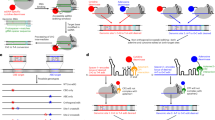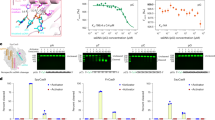Abstract
Quantitative real-time PCR was utilized to evaluate retroviral vector titer. RNA was prepared from vector supernatant and run in a one-step RT-PCR reaction combining reverse transcription (RT) and amplification in one tube. Sample analysis was performed in the ABI Prism 7700 Sequence Detector. PCR was quantitative over a range of 101 to 6 × 105 vector particles per reaction (2 × 102 to 1 × 107 vector particles per millilites of supernatant) and closely corre- lated with biologic titers performed on the test material. The 96-well capacity of the machine and 2 h of running time permit titer determinations within 8 h, facilitating the processing of large sample numbers while greatly decreasing technician time. Real-time PCR improves titer quantification and the identification of high-titer producer cells. This methodology will help investigators meet the challenges of developing vectors which lack selectable markers.
This is a preview of subscription content, access via your institution
Access options
Subscribe to this journal
Receive 12 print issues and online access
$259.00 per year
only $21.58 per issue
Buy this article
- Purchase on Springer Link
- Instant access to full article PDF
Prices may be subject to local taxes which are calculated during checkout




Similar content being viewed by others
References
Armentano D et al. Effect of internal viral sequences on the utility of retroviral vectors J Virol 1987 61: 1647–1650
Bender MA, Palmer TD, Gelinas RE, Miller AD . Evidence that the packaging signal of Moloney murine leukemia virus extends into gag region J Virol 1987 61: 1639–1646
Williams DA, Hsieh K, DeSilva A, Mulligan RC . Protection of bone marrow transplant recipients from lethal doses of methotrexate by the generation of methotrexate-resistant bone marrow J Exp Med 1987 166: 210–218
Hock RA, Miller AD . Retrovirus-mediated transfer and expression of drug resistance genes in human haematopoietic progenitor cells Nature 1986 320: 2775–2777
Malvilio F et al. Peripheral blood lymphocytes as target cells of retroviral mediated gene transfer Blood 1994 83: 1988–1997
Riddell SR et al. T-cell mediated rejection of gene-modified HIV-specific cytotoxic T lymphocytes in HIV-infected patients Nature Med 1996 2: 216–223
Heim D et al. In vivo persistence of rhesus monkey lymphocytes transduced with a non-expressing retroviral vectors compared to rapid clearance of lymphocytes transduced with a neo-expressing vector Am Soc Gene Ther 1998 1: 89a (Abstr. 352)
Murdoch B et al. A rapid screening procedure for the identification of high-titer retrovirus packaging clones Gene Therapy 1997 4: 744–749
Huszar D, Ellis J, Bernstein A . A rapid and accurate method for determining the titer of retrovirus vectors lacking a selectable marker Technique 1989 1: 28–32
Tufuro S, Zentilin L, Falaschi A, Giacca M . Rapid retrovirus titration using competitive polymerase chain reaction Gene Therapy 1996 3: 679–684
Gerard CJ et al. Improved quantitation of minimal residual disease in multiple myeloma using real-time polymerase chain reaction and plasmid-DNA complementarity determining region III standards Cancer Res 1998 58: 3957–3964
Desjardin LE et al. Comparison of the ABI 7700 System (TaqMan) and competitive PCR for quantification of IS6110 DNA in sputum during treatment of tuberculosis J Clin Microbiol 1998 36: 1964–1968
Markowitz D, Goff S, Bank A . Construction and use of a safe and efficient amphotropic packaging line Virology 1988 167: 400–406
Markowitz D, Goff S, Bank A . A safe packaging line for gene transfer: separating viral genes on two different plasmids J Virol 1988 62: 1120–1124
Miller AD et al. Construction and properties of retrovirus packaging cells based on gibbon ape leukemia virus J Virol 1991 65: 2220–2224
Kotani H et al. Improved methods of retroviral vector transduction and production for gene therapy Hum Gene Ther 1994 5: 19–28
Kirkwood TBL, Bangham CRM . Cycles, chaos, and evolution in virus cultures: a model of defective interfering particles Proc Natl Acad Sci USA 1994 91: 8685–8689
Le Doux JM, Morgan JR, Snow RG, Yarmush ML . Proteoglycans secreted by packaging cell lines inhibit retrovirus infection J Virol 1997 70: 6468–6473
Davis JL et al. Retroviral particles produced from a stable human-derived packaging cell line transduce target cells with very high efficiencies Hum Gene Ther 1997 8: 1459–1467
Acknowledgements
This work was supported by a Centers of Excellence in Molecular Hematology grant (P50 DK49218) and P01 HL53586. Vectors analyzed in this study were produced for clinical gene therapy trials, work supported by the National Gene Vector Laboratory grant (U42 RR11148). We would like to thank Lilith Reeves, Lorraine Rubin and the other members of the Indiana University Vector Production Facility for their contributions to this manuscript.
Author information
Authors and Affiliations
Rights and permissions
About this article
Cite this article
Sanburn, N., Cornetta, K. Rapid titer determination using quantitative real-time PCR. Gene Ther 6, 1340–1345 (1999). https://doi.org/10.1038/sj.gt.3300948
Received:
Accepted:
Published:
Issue Date:
DOI: https://doi.org/10.1038/sj.gt.3300948
Keywords
This article is cited by
-
Shedding dynamics of Morogoro virus, an African arenavirus closely related to Lassa virus, in its natural reservoir host Mastomys natalensis
Scientific Reports (2015)
-
Rapid titration of retroviral vectors using a β-lactamase protein fragment complementation assay
Gene Therapy (2013)
-
A reporter system for replication-competent gammaretroviruses: the inGluc-MLV-DERSE assay
Gene Therapy (2013)
-
High-titer preparation of Bombyx mori nucleopolyhedrovirus (BmNPV) displaying recombinant protein in silkworm larvae by size exclusion chromatography and its characterization
BMC Biotechnology (2009)
-
Retroviral vectors for clinical immunogene therapy are stable for up to 9 years
Cancer Gene Therapy (2008)



